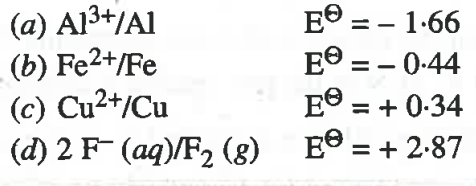Discuss the method to determine cell potential of any cell when standard hydrogen electrode is considered as anode with suitable example.
Text Solution
(a) Reduction potential : A 298K the emf of the cell, standard hydrogen electrode and second half-cell constructed by taking standard hydrogen electrode as anode (reference half-cell) and the other half-cell as cathode gives the reduction potential of the other half-cell.
Standard: hydrogen electrode half-cellanode half-cell∣∣another half-cellcathode half-cell
Cell potential=(Reduction potential of other cell)
=emf value of another half-cell.
(b) Explanation with general example:
(i) If the concenctrations of the oxidised and the reduced forms of the species in the right-hald half-cell are unity, then the cell potential is equal to the standard electrode potential.
General: cell
Pt∣∣H2(g)(1 bar)∣∣H+(aq)(1M)∣∣∣∣
∣∣Mn+(aq)(1M)metal ion∣∣
∣∣M(S)metal
(ii) EΘ=EΘR−EΘL:
Where EΘ=standard reduction potential of cell
EΘR=standard reduction potential of cell present on right side.
EΘL=standard reduction potential of cell present on left side.
As EΘL=for standard hydrogen electrode is zero
∴EΘ=(EΘR−0.0)
EΘ=EΘR . . (i)
(iii) Hydrogen half-cell || copper half-cell:
Pt∣∣H2(g)(1 bar)∣∣H+(aq)(1M)∣∣∣Cu2+(aq)(1M)∣∣Cu(S)
The measured emf of the cell is +0.34 V and it is also the value for the standard electrode potential of the half-cell corresponding to the reaction:
Oxidation left hand side : H2(g)→2H+(aq)+2e− ∴EΘL=0.0V
Reduction right hand side: Cu2+(aq)+2e−→Cu(S)
∴EΘcell=(EΘR−EΘL)=0.34
∴EΘR=EΘcell=0.34V
∴EΘcell=EΘR
Cu2+(aq)(1M)+2e−→Cu(S)
and its standard reduction potential Cu2+∣Cu=+0.34V
So, as
Pt(S)∣∣H2(g, 1 bar)∣∣H+aq1M∣∣∣Zn2+aq1M∣∣Zn=−0.76V
Note : When standard hydrogen electrode is on left side and working as anode then other half-cell has positive reduction potential value and such cell possess positive emf value. this shows that Cu2+ ion does not get reduced easilywith respect to H+ ions and hence reaction does not occur in backward direction.
|
Topper's Solved these Questions
- ELECTROCHEMISTRYBOOK - KUMAR PRAKASHANCHAPTER - ELECTROCHEMISTRYEXERCISE - SECTION-A (Try Yourself)
25 Videos
- ELECTROCHEMISTRYBOOK - KUMAR PRAKASHANCHAPTER - ELECTROCHEMISTRYEXERCISE - SECTION-A (Practice Questions)
3 Videos
- ELECTROCHEMISTRYBOOK - KUMAR PRAKASHANCHAPTER - ELECTROCHEMISTRYEXERCISE - SECTION-E MCQ.s Asked in GUJCET/Board Exam
55 Videos
- CHEMISTRY IN EVERYDAY LIFEBOOK - KUMAR PRAKASHANCHAPTER - CHEMISTRY IN EVERYDAY LIFEEXERCISE - SECTION - E (MCQs ASKED IN GUJCET/BOARD EXAM)
37 Videos
- GENERAL PRINCIPLES AND PROCESSES OF ISOLATION OF ELEMENTSBOOK - KUMAR PRAKASHANCHAPTER - GENERAL PRINCIPLES AND PROCESSES OF ISOLATION OF ELEMENTSEXERCISE - SECTION - E (MCQs ASKED IN GUJET/BOARD EXAMS)
46 Videos
Similar Questions
Knowledge Check
Standard electrode potential of normal hydrogen electrode is :
A0.5 VB+1.5VC0.0 VD+0.5VStandard cell electrode potential is expressed as
AE0cell=E0red(R.H.S.)−E0Oxi(L.H.S)BE0cell=E0red(L.H.S.)+E0Oxi(R.H.S)CE0cell=E0oxi(Anode)+E0Oxi(Cathode)DE0cell=E0red(R.H.S.)+E0Oxi(L.H.S)For a cell reaction : Mn+(aq)+ne−→M(s), the Nernst equation for electrode potential at any concertation measured with respect to standard hydrogen electrode is represented as
AE(Mn+/M)=E∘(Mn+/M)−RTnFln(1[Mn+])BE(M/Mn+)=E∘(M/Mn+)−RTnFln([Mn+][M])CE(Mn+/M)=E∘(Mn+/M)−RTnFlog1[M]DE(Mn+/M)=E∘(Mn+/Mn+)−RTnFln[Mn+]
Which of the following electrodes will act as anodes when connected to standard hydrogen electrode?

View SolutionIntroduction to elctrochemistry|daniel cell|electrode potential| standard hydrogen electrode|electrochemical series
View SolutionFor a cell reaction : Mn+(aq)+ne−→M(s), the Nernst equation for electrode potential at any concertation measured with respect to standard hydrogen electrode is represented as
View SolutionThe half cell potential of a hydrogen electrode at pH = 10 will be
View SolutionAssertion:A standard hydrogen electrode is also called reversible electrode.
Reason : Standard hydrogen electrode can act both as anode as well as cathode in an electrochemical cell.
View Solution
